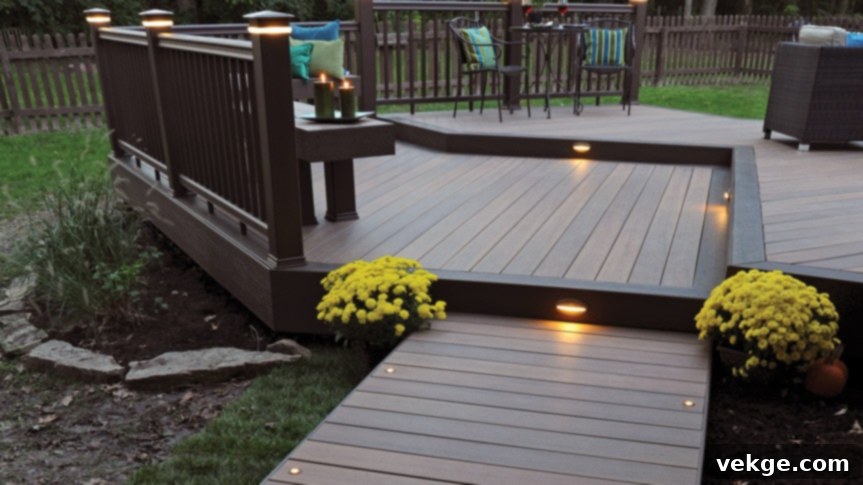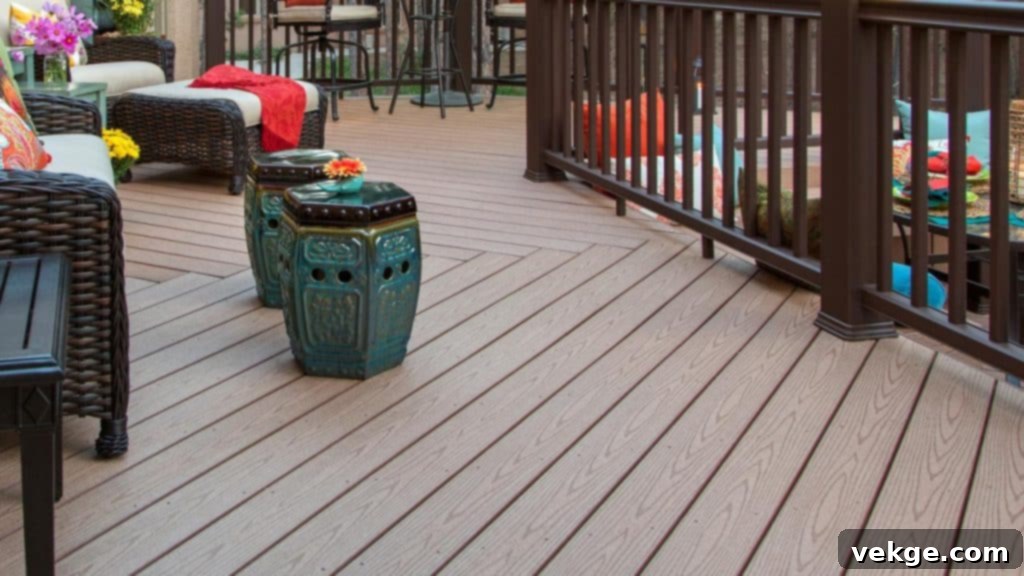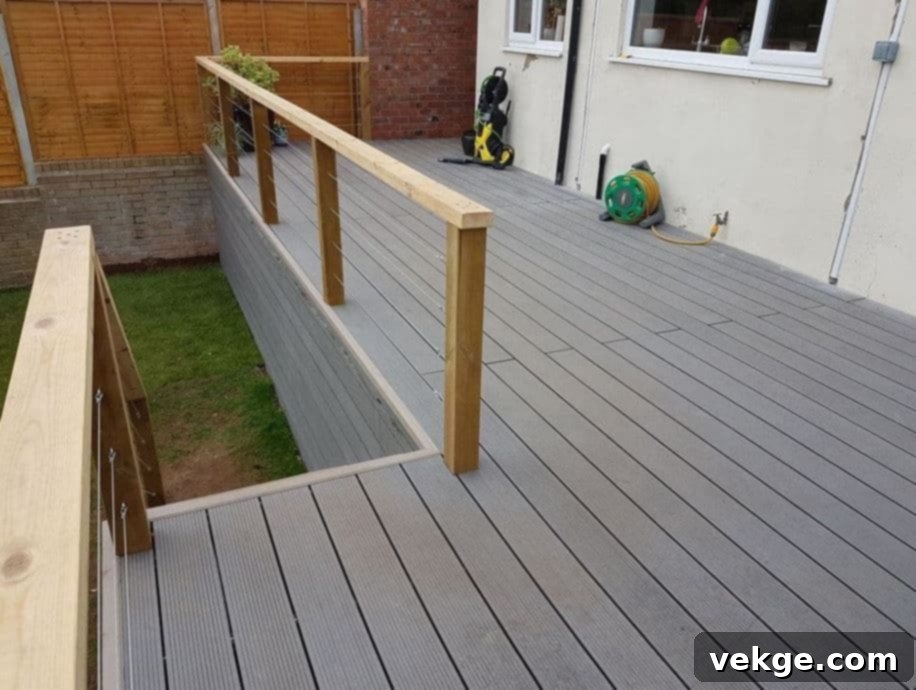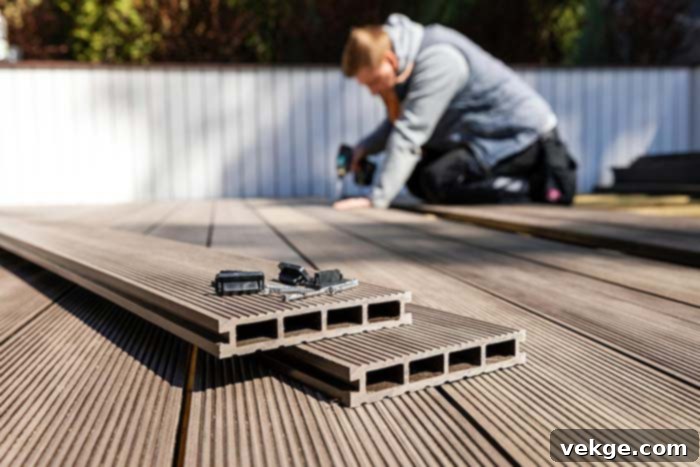The Ultimate Guide to Sustainable Composite Decking: Eco-Friendly, Durable & Low Maintenance Outdoor Living
The desire for a beautiful outdoor space – perfect for vibrant summer barbecues, serene morning coffees, or simply unwinding under the sun – resonates deeply with many homeowners. For generations, traditional wooden decks have been the classic choice, evoking a sense of natural charm. However, the reality of owning a conventional timber deck often involves a cycle of relentless maintenance. Homeowners frequently grapple with the looming threats of rot, persistent warping, bothersome splinters, and destructive insect infestations. These ongoing issues can quickly transform a dream deck into a source of frustration, demanding considerable time, effort, and financial investment.
This challenging scenario is precisely why sustainable composite decking has emerged as a true game-changer in the world of outdoor living. It’s more than just an alternative; it represents a modern evolution, offering the timeless aesthetic appeal of natural wood without any of the traditional headaches. Furthermore, choosing composite decking is an inherently eco-friendly decision, allowing homeowners to build their ideal outdoor sanctuary while actively contributing to a healthier planet. It’s a choice that brings both personal satisfaction and environmental responsibility into harmonious balance.
The Innovative Composition of Sustainable Composite Decking

To fully grasp why composite decking consistently outperforms its traditional counterparts, it’s crucial to delve into its fundamental structure. Unlike pure wood, which is a singular natural material, composite decking is an advanced engineered product. It is meticulously manufactured from a sophisticated blend of various components, each carefully selected for its unique properties. This ingenious composition is the core secret behind its exceptional strength, durability, and resistance. What makes it even more appealing is that a significant portion of this innovative blend consists of recycled materials, firmly establishing it as a leading eco-conscious option in modern construction.
Recycled Materials: The Foundation of Eco-Friendly Decking

At its essence, composite decking is crafted by combining two principal categories of materials: carefully processed wood fibers and robust recycled plastics. It is the sophisticated synergy between these distinct components, often bound together with specialized additives, that endows composite decking with its remarkably unique and highly desirable characteristics, making it exceptionally resilient, durable, and long-lasting.
Wood Fibers: Capturing Natural Aesthetics Sustainably
The wood fibers integrated into composite decking are primarily sourced from industrial waste streams, such as fine sawdust, wood chips, and other cellulose-based byproducts from sawmills and wood processing plants. Instead of these valuable materials being discarded as waste and contributing to landfill burdens, they are ingeniously reprocessed and given a crucial second life. This innovative circular economy approach not only minimizes waste but also contributes significantly to a more sustainable and resource-efficient manufacturing process.
The incorporation of these wood fibers offers a dual advantage. Firstly, they impart to the composite material a natural, organic look and feel that beautifully mimics traditional wooden decking. This provides a desirable warmth and authentic aesthetic appeal to any outdoor setting. Secondly, and vitally, once these wood fibers are thoroughly encapsulated and protected within the durable composite matrix, they gain an extraordinary resistance to the common vulnerabilities of pure timber. This includes immunity to rotting, warping, and the destructive damage caused by insects such as termites and carpenter ants. This inherent, built-in protection ensures your composite deck maintains its structural integrity and visual appeal for decades, significantly reducing the need for harsh chemical treatments often associated with wood.
Recycled Plastics: Engineering for Unrivaled Durability
The other critical material employed in the fabrication of composite decking is recycled plastics. These plastics originate from a diverse range of post-consumer and post-industrial sources, including everyday items like discarded shopping bags, sturdy milk jugs, versatile detergent bottles, and various plastic wrappers. By effectively diverting these materials from landfills, incinerators, and natural environments, composite decking plays a pivotal role in mitigating plastic pollution and transforming these once-discarded resources into high-value, long-lasting products.
The strategic inclusion of recycled plastics is paramount to the composite deck’s superior performance, bestowing upon it a unique set of unparalleled benefits. Primarily, these plastics contribute an exceptional level of durability, structural stability, and resilience that far exceeds what traditional wood can offer. Composite decks are specifically engineered to resist splintering and cracking, providing a consistently smooth and safe surface for bare feet and hands. Furthermore, the inherent moisture resistance of plastic provides an unparalleled barrier against water absorption. This effectively prevents pervasive issues like rot, destructive mildew, and unsightly mold growth – common and persistent problems that typically plague natural wood decks and demand constant, often costly, vigilance.
This intelligent and purposeful combination of wood fibers for aesthetic appeal and recycled plastics for robust, long-term durability results in a decking material that is truly a cut above the rest. The manufacturing process typically involves heating and extruding these meticulously mixed materials under high pressure, often incorporating specialized binding agents and UV stabilizers, to form solid, consistent, and exceptionally durable deck boards.
To provide a concise overview, the table below briefly compares the distinct properties and advantages contributed by wood fibers and recycled plastics in the innovative construction of composite decking.
| Material Component | Key Properties Imparted to the Decking |
|---|---|
| Wood Fibers | Authentic natural aesthetic, familiar texture and feel, intrinsic resistance to rot, warping, and insect damage (when integrated within composite) |
| Recycled Plastics | Superior durability, resistance to splintering, cracking, exceptional moisture resistance, effective prevention of rot, mold, and mildew, UV stability |
Considering all the aspects detailed above, it becomes unequivocally clear that the sophisticated and engineered composition of composite decking fundamentally distinguishes it from conventional wooden decks. More profoundly, its inherent eco-friendly nature offers the significant added advantage of effectively reducing waste generation and minimizing adverse environmental impact – crucial benefits that are widely appreciated and increasingly essential for the long-term health of our planet.
Unlocking Profound Environmental Benefits with Composite Decking

The decision to transition from traditional wooden decks to sustainable composite decking is a meaningful step towards a more responsible and ecologically sound lifestyle. By opting for these innovative materials, homeowners actively contribute to a wide array of ecological benefits, thereby helping to cultivate a greener, more sustainable planet for both current and future generations. Let’s explore the significant ways in which this choice helps shrink our collective environmental footprint and promotes global sustainability.
Reducing Waste and Pollution: Giving Materials a Valuable Second Life
One of the most impactful environmental contributions of composite decking stems directly from its manufacturing process, which ingeniously incorporates high volumes of recycled plastics and reclaimed wood fibers. These materials, often considered byproducts of other industries or post-consumer waste, would otherwise be destined for rapidly expanding landfills, contributing to significant land pollution and the wasteful depletion of finite resources. For instance, the plastic components frequently originate from everyday items that, without proper recycling, would persist as unsightly and harmful litter in our natural landscapes and delicate ocean ecosystems, posing severe threats to wildlife. By effectively giving these materials a valuable and durable second life in decking products, the composite decking industry plays a crucial role in dramatically reducing overall waste volume and mitigating the pervasive environmental pollution associated with both the production of new virgin materials and the problematic disposal of old ones.
Conserving Natural Resources: Protecting Our Vital Forests
The global imperative to conserve our precious natural forests is more urgent than ever before. Traditional wooden decks, while possessing a classic appeal, inevitably contribute to the demand for freshly cut timber, which can place immense and unsustainable pressure on vulnerable forest ecosystems worldwide. Sustainable composite decks offer a powerful and practical solution by significantly reducing this reliance on virgin timber. Rather than consuming newly harvested trees, composite decking primarily integrates wood fibers that are typically procured as byproducts from existing timber production processes or sourced from sustainably managed, rapidly renewable resources. This responsible approach substantially lessens the need for new deforestation, thereby preserving ancient forests, safeguarding invaluable biodiversity, and supporting the health of vital carbon sinks that are essential for regulating our global climate.
Lowering Carbon Footprint: A Greener Production and Lifecycle

The entire lifecycle of composite decking, from production to disposal, actively contributes to a lower overall carbon footprint. Many modern composite decking factories are designed with advanced energy-efficient technologies, often employing eco-friendly processes that significantly reduce harmful greenhouse gas emissions released into the atmosphere. Crucially, by integrating a substantial amount of recycled materials, the energy required for manufacturing composite boards is frequently less than that needed for products made entirely from virgin resources. Furthermore, the exceptional longevity and durability of composite decks mean they require less frequent replacement. This extended service life dramatically reduces the environmental impact associated with repetitive new production, resource-intensive transportation, and eventual disposal over several decades. This prolonged lifespan also minimizes the need for energy-intensive and often chemical-dependent maintenance activities such as sanding, staining, and sealing, which can further impact the environment.
By thoughtfully adopting sustainable composite decking, we not only gain the advantages of a hassle-free, aesthetically pleasing, and low-maintenance outdoor solution for our homes, but we also make a tangible and significant contribution to cultivating a greener, more sustainable future. Choosing sustainable building materials for our outdoor spaces might feel like a modest individual step, yet collectively, it represents an undeniably powerful and essential stride in the right direction for the health and vitality of Mother Earth. For those specifically located in regions like Sydney, Australia, finding reliable decking providers such as Woodevo, who specialize in Composite decking in Sydney, can make this sustainable transition even more accessible and seamless.
The comparative environmental benefits between composite and traditional wood decking are striking and clearly demonstrate the superior ecological choice:
| Environmental Impact Category | Sustainable Composite Decks | Traditional Wooden Decks |
|---|---|---|
| Waste Production | Low (significant utilization of recycled materials, actively diverting waste from landfills and ecosystems) | Higher (direct reliance on new timber, potential for substantial wood waste during processing and disposal) |
| Resource Consumption | Significantly less (minimizes demand for virgin timber, primarily utilizes reclaimed wood fibers and recycled plastics) | More (direct and often unsustainable reliance on freshly cut trees, depleting natural forests) |
| Carbon Footprint | Reduced (eco-friendly manufacturing processes, lower energy consumption due to recycled content, extended product lifespan reducing frequent replacement cycles) | Higher (logging, intensive processing of virgin timber, shorter lifespan often leading to more frequent replacement and associated emissions) |
Unmatched Durability and Longevity for Decades of Enjoyment

Beyond its commendable environmental credentials, one of the most compelling and tangible benefits that consistently attracts homeowners to sustainable composite decking is its unparalleled durability and exceptional longevity. This advanced, engineered material is meticulously designed to effortlessly withstand the relentless test of time and the harshest of environmental elements, offering a level of resilience that traditional timber simply cannot match. Investing in composite decking translates into securing an outdoor space that will retain its aesthetic appeal and functional integrity for many decades, significantly enhancing both the inherent value and the daily enjoyment of your home.
Superior Resistance to All Elements and Pests
Composite decking is engineered with a sophisticated composition specifically formulated to resist nearly all the common issues that severely plague natural wood. This comprehensive resistance includes:
- Moisture and Destructive Rot: Unlike permeable wood, which readily absorbs water and becomes highly susceptible to rot, pervasive mold, and unsightly mildew, composite materials are inherently moisture-resistant. This prevents not only unsightly growth but also the structural degradation that compromises wooden decks.
- Insect Infestation: Destructive termites, insidious carpenter ants, and other common wood-boring insects pose absolutely no threat to composite decking, as the integrated plastic components render the material inedible and entirely unattractive to these pests.
- Fading and Harmful UV Damage: Many advanced composite boards are manufactured with a protective co-extruded cap layer that provides superior UV resistance. This technology significantly minimizes color fading and material degradation caused by prolonged exposure to intense sunlight, ensuring your deck’s vibrant look endures.
- Warping, Twisting, and Splintering: The unique, engineered blend of wood fibers and plastics ensures exceptional dimensional stability. This actively prevents the warping, twisting, and splintering that are typical with natural wood as it expands and contracts with fluctuations in temperature and humidity. This stability also guarantees a consistently smooth and safe surface, perfect for bare feet.
- Stains and Abrasions: Many premium composite decks feature advanced surface technology that makes them highly resistant to stains from common spills like food, beverages, and household chemicals, as well as everyday scratches and scuffs, maintaining a pristine appearance with minimal effort.
Minimal Maintenance Requirements: Enjoy Your Deck, Don’t Toil On It
Perhaps one of the most widely celebrated attributes of sustainable composite decks is their remarkably low maintenance profile, especially when contrasted with the demanding upkeep required by their timber counterparts. Homeowners can genuinely maximize their enjoyment of their outdoor space without dedicating precious weekends to its arduous maintenance. A simple, occasional wash with mild soap and water is typically the only requirement to keep these decks looking pristine and new, year after year. This effortless upkeep stands in stark contrast to the rigorous, time-consuming, and often costly maintenance regimen demanded by wooden decks:
- No Staining or Sealing: Natural wood requires regular staining or sealing, typically every 1-3 years, to protect it from moisture penetration and UV damage. This is a labor-intensive, often messy, and repetitive process. Composite decks eliminate this entirely.
- No Sanding or Painting: To address splinters, peeling paint, or uneven surfaces, wooden decks frequently necessitate extensive sanding and repainting. Composite decks are engineered never to require these laborious tasks.
- No Pest Treatments: Wood decks may need periodic chemical treatments or inspections to prevent costly insect infestations. Composite decks are naturally impervious to pests, offering peace of mind.
A comprehensive survey conducted by Consumer Reports starkly highlighted the significant financial benefits of choosing composite decking. The study found that over a 20-year period, homeowners could save an estimated $3,000 to $5,000 (and often substantially more) in maintenance costs alone by opting for composite decks compared to the extensive upkeep required for traditional wooden ones. These substantial savings, combined with the material’s extended lifespan, firmly establish composite decking as a truly economically savvy and value-enhancing investment for any home.
| Decking Material | Estimated Savings in Maintenance (Over 20 Years) | Typical Annual/Biennial Maintenance Tasks |
|---|---|---|
| Traditional Wood | $0 (incurs significant ongoing costs) | Annual or biennial sanding, staining/sealing, painting, pest treatments, replacing rotted or warped boards, pressure washing |
| Sustainable Composite | $3,000 – $5,000+ | Simple occasional cleaning with mild soap and water (as needed) |
The inherent structural strength of composite decking, coupled with its impressive resistance to harsh weather conditions, moisture, damaging insects, and general wear-and-tear, unequivocally contributes to its superior durability and offers distinct, undeniable advantages over traditional decking materials. It’s vital to remember the substantial money and precious time composite decks can save us in the long run! This truly makes it the quintessential hassle-free, exceptionally durable, and ultimately cost-effective solution for creating enjoyable and resilient outdoor living spaces that require minimal fuss. Little to no maintenance, significantly reduced waste, a substantially lower carbon footprint, and lasting beauty – these are the compelling reasons we emphatically endorse composite decking! To succinctly summarize these remarkable features, composite decks are undeniably the pathway to greener, more enjoyable, and truly sustainable outdoor living for the modern homeowner.
Aesthetics and Design Versatility: Crafting Your Dream Outdoor Oasis
Beyond its impressive environmental credentials and outstanding practical benefits, sustainable composite decking truly excels in terms of aesthetic appeal and unparalleled design versatility. Modern manufacturing techniques have advanced significantly, allowing composite boards to meticulously mimic the natural beauty and intricate grain patterns of various genuine wood species – from the rich, deep tones of exotic hardwoods to the charming, weathered look of seasoned softwoods. This is achieved without any of the associated environmental impact of logging old-growth forests or the burdensome maintenance demands that come with natural timber.
- Diverse Color Palettes: Composite decking is available in an expansive array of colors, ranging from warm, inviting earth tones and sophisticated classic grays to bold, vibrant contemporary shades. Crucially, these colors are an integral part of the board’s composition, meaning they will not chip, peel, or require repainting, ensuring they maintain their deep, consistent vibrancy and fresh appearance for many years.
- Authentic Textures and Finishes: Manufacturers have refined their processes to create incredibly realistic wood grain patterns, subtle brushed finishes, and even artistically distressed looks. This extensive variety allows homeowners to achieve the precise aesthetic they envision for their deck, whether it’s a rustic retreat, a sleek modern lounge, or a traditional family gathering space, all with a perfectly consistent and enduring finish across every board.
- Enhanced Design Flexibility: The consistent dimensions, structural integrity, and ease of cutting of composite boards make them exceptionally well-suited for complex and imaginative deck designs. This includes graceful curves, dynamic multi-level structures, intricate inlay patterns, and custom shapes. Furthermore, many composite decking systems offer hidden fastening options, resulting in a beautifully clean, fastener-free surface that significantly enhances the deck’s sophisticated and seamless look, providing a truly high-end finish.
- Complementary Accessories: A full and comprehensive suite of matching accessories, including elegant railings, streamlined fascia boards, sturdy stair treads, and decorative post caps, ensures a perfectly cohesive and polished final appearance for your entire outdoor living space, tying every element together harmoniously.
This remarkable design flexibility empowers both homeowners and professional designers to create bespoke outdoor environments that perfectly complement their home’s architectural style and their unique personal taste. It allows for seamless integration with both natural landscape surroundings and cutting-edge contemporary garden designs, making composite decking the ultimate choice for personalized outdoor sanctuaries.
Conclusion: Embrace a Greener, Smarter Outdoor Future
As we have thoroughly explored throughout this guide, sustainable composite decking unequivocally stands out as the superior choice for modern outdoor living. It is far more than just an environmentally friendly option; it is a profoundly smart, strategic investment that offers an unparalleled array of benefits. The substantial long-term financial savings derived from its minimal maintenance requirements, coupled with its inherent durability and significantly extended lifespan, are simply too compelling and economically advantageous to overlook. With composite decking, you gain a stunning, highly functional outdoor space without the constant burden and worry of hefty upkeep costs, the environmental degradation associated with traditional materials, or the cyclical replacement common with natural wood.
It truly represents a genuine win-win situation: homeowners get to luxuriate in beautiful, meticulously maintained outdoor areas that enhance their lifestyle, all while actively contributing to a healthier and more sustainable planet. Moreover, an attractive, low-maintenance composite deck can dramatically enhance your property’s curb appeal and overall market value, making it a wise investment that consistently pays dividends in both elevated quality of life and increased home equity.
Making the thoughtful switch to composite decking is a decision you will undoubtedly appreciate and benefit from for decades to come. It signifies a forward-thinking investment in your cherished home, the boundless enjoyment of your family, and the collective well-being of our precious planet. Let’s wholeheartedly embrace this sustainable, high-performance, and aesthetically versatile solution, unlocking the full, transformative potential of our outdoor living spaces. After all, who truly says we can’t have a breathtakingly beautiful deck and maintain a clear, clean conscience simultaneously?
